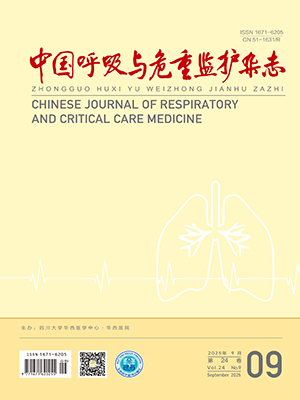| 1. |
慢性阻塞性肺疾病急性加重 (AECOPD) 诊治专家组. 慢性阻塞性肺疾病急性加重 (AECOPD) 诊治中国专家共识 (2017 年修订版). 国际呼吸杂志, 2017, 37(14): 1041-1057.
|
| 2. |
Edwards L, Perrin K, Wijesinghe M, et al. The value of the CRB65 score to predict mortality in exacerbations of COPD requiring hospital admission. Respirology, 2011, 16(4): 625-629.
|
| 3. |
Global Initiative for Chronic Obstructive Lung Disease(GOLD): Global Strategy for the Diagnosis, Management and Prevention of Chronic Pulmonary Disease(2017 REPORT). http://www.goldcopd.org.
|
| 4. |
Hennemann G, Krenning EP. The kinetics of thyroid hormone transporters and their role in non-thyroidal illness and starvation. Best Pract Res Clin Endocrino Metab, 2007, 21(2): 323-338.
|
| 5. |
Plikat K, Langgartner J, Buettner R,et al. Frequency and outcome of patients with nonthyroidal illness syndrome in a medical intensive care unit. Metabolism, 2007, 56(2): 239-244.
|
| 6. |
Sahana PK, Ghosh A, Mukhopadhyay P, et al. A study on endocrine changes in patients in intensive care unit[J]. J Indian Med Assoc, 2008, 106(6): 362-364.
|
| 7. |
Adler SM, Wartofsky L. The nonthyroidal illness syndrome. Endocrinol Metab Clin North Am, 2007, 36(3): 657-672.
|
| 8. |
高绪文, 李继莲. 甲状腺疾病. 北京: 人民卫生出版社, 1999, 157-158.
|
| 9. |
俞春娟, 和明丽, 王俊军, 等. 慢性阻塞性肺疾病急性加重期低 T3 综合征及其临床意义. 上海医药, 2014, 35(17): 34-37.
|
| 10. |
程洋, 戴丽, 夏国光. 慢性阻塞性肺疾病急性加重患者血清甲状腺激素水平变化及临床意义. 中华结核和呼吸杂志, 2016, 39 (12): 939-943.
|
| 11. |
程洋, 戴丽, 张运剑, 等. 慢性阻塞性肺疾病急性加重期患者血清甲状腺激素水平与疾病严重程度的相关性. 中国医药, 2017, 12(6): 855-857.
|
| 12. |
周清, 吴琦. 老年 COPD 患者肺功能与血清甲状腺激素的相关性分析. 山东医药, 2012, 52(12): 92-94.
|
| 13. |
罗洁, 王德明. 非甲状腺疾病综合征对危重症患者的影响. 中国实用医药, 2010, 5(36): 247-248.
|
| 14. |
吴红花, 高燕明. 老年病与正常甲状腺病态综合征. 中华老年多器官疾病杂志, 2011, 10(6): 570-572.
|
| 15. |
余松林. 医学统计学. 北京: 人民卫生出版社, 2002, 164-178.
|




